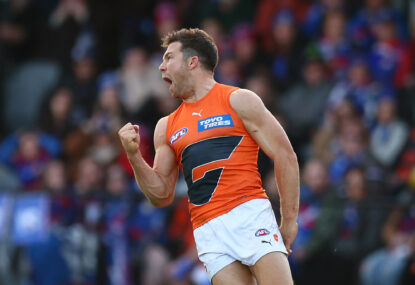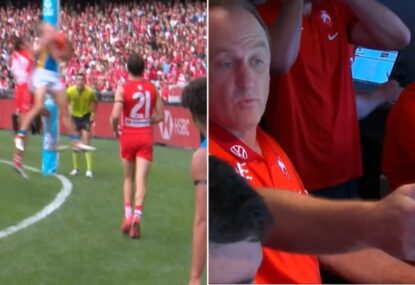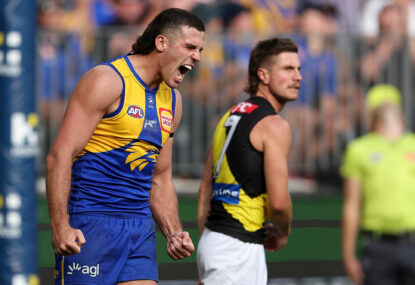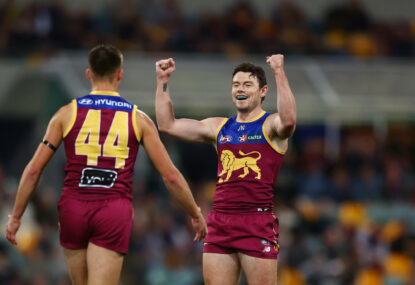In November, 2018, I put out a series of twenty articles (with two follow-ups) detailing the seasons in meta-review form for each of the eighteen men’s teams in the Australian Football League.
I produced a final order of teams for 2019 back then that didn’t necessarily take everything into account (it was pre-draft, for one thing), but seemed to me to be a reasonable forecast for the season to come.
I’m sure my friends in editing will link to it if they don’t think I’ll be too embarrassed by it.
But I want to share with you one of my yearly passions on this topic, and that’s compiling every possible prediction I can find by people who should have some rational reasoning behind their prophecies.
While I’m still collecting, there are more than enough in the data bank now that the final order seems pretty much solidified. I’ll share that with you as well in a minute.
Finally, I tried taking those meta-rankings for the teams, plugging it into the 2019 fixture with some home-field parameters and a common-sense descriptor for how much each ranking position translated into for a margin, and played out the season in a very rough manner, to see how the season might result from the consensus rankings.
(Completely ignoring possible injuries, weather issues, and our just being plain wrong about our predictions, which of course never happens.)
Got it? Good! Here are the meta-rankings by the Australian press and public, averaged with a little bit of weight (Ryan Buckland’s opinion, for example, will matter more than Random YouTuber with 4K views, and all the Reddit lists were combined into one vote):
1. Richmond (average position – 1.6, ranging from 1st to 3rd)
2. Melbourne (average position – 2.9. ranging from 1st to 6th)
3. West Coast (average position – 3.9, ranging from 1st to 8th)
4. Collingwood (average position – 4.0, ranging from 2nd to 9th)
5. Essendon (average position – 6.1, ranging from 4th to 10th)
6. Adelaide (average position – 6.9, ranging from 2nd to 12th)
7. GWS Giants (average position – 7.2, ranging from 3rd to 11th)
8. Geelong (average position – 8.0, ranging from 2nd to 13th)
9. Hawthorn (average position – 8.6, ranging from 3rd to 15th)
10. Sydney (average position – 10.2, ranging from 6th to 15th)
11. North Melbourne (average position – 10.9, ranging from 6th to 15th)
12. Port Adelaide (average position – 11.2, ranging from 9th to 15th)
13. Brisbane (average position – 11.4, ranging from 7th to 15th)
14. Western BD (average position – 13.9, ranging from 10th to 16th)
15. Fremantle (average position – 14.1, ranging from 11th to 17th)
16. St Kilda (average position – 15.7, ranging from 13th to 17th)
17. Carlton (average position – 16.5, ranging from 14th to 18th)
18. Gold Coast (average position – 17.9, ranging from 17th to 18th)
A few grouping observations before we continue: There seem to be five tiers to the meta-prediction averages.
Tier I – The Championship favourites
Even within the tier, Richmond has a clear gap over their three perceived primary challengers – Melbourne and the two grand finalists, Collingwood and West Coast.
Last season’s four preliminary finalists have the obvious advantage of having recent finals success, and without suffering any obvious losses (like Hawthorn did, losing their Brownlow medalist for the year), they deserve that recognition.
History suggests that one of the four will falter terribly and fail to make finals, while a team from below this tier will, at the very least, spend the year among the remaining three and get a double chance at the title this spring.
(And if you can predict which teams those two will be, you’re more of a seer than I am. Did you pick WC/Pies in the fall? Didn’t think so. Neither did I.)

Sam Lloyd of the Tigers celebrates (Photo by Michael Willson/AFL Media/Getty Images)
Tier II – The Possible Contenders
The other four finalists are presumed to be coming from these five candidates: Essendon (following a great last two-thirds of 2018), Adelaide (perceived to have had a “one-off” year in 2018 after a minor premiership in ’17), GWS (the thought seems to be that until the perennial contenders prove they’re no longer finalist material, we assume they still are) and Geelong (see GWS).
The fifth team is Hawthorn. Yes, they’re fading; yes, they lost Mitchell for the year; yes, finals suggest they’re on the verge of collapse – but they still have Alastair Clarkson, and they were still third in the league last year.
Any one of those five could end up in the top four and maybe as a grand finalist. Any one of them could be 2016 Fremantle redux. And it’s probable that at least one of these five will fit each profile – remember, in the 28-year history of the AFL, there have always been two to four teams move into finals who weren’t there the year before. For once, we’ve corporately picked two: Essendon and Adelaide. Odds are there’ll be one more.

James Worpel of the Hawks marks during the AFL Semi Final match between the Hawthorn Hawks and the Melbourne Demons at the Melbourne Cricket Ground on September 14, 2018 in Melbourne, Australia. (Photo by Quinn Rooney/Getty Images)
Tier III – O, Ye Of Little Faith
Strangely, the four teams which ended up in slots 10 through 13 all look like they should be contending for finals, and yet virtually nobody put any of them in their top eight.
Out of 35 predictions collected so far (and counting), only five of them put Sydney in their top eight.
That’s still better than North, who got only two forecasts of finals faith, and I have yet to find a single prediction that has Port Adelaide playing in September.
Only Brisbane had folks shooting for the moon, and that’s because people really don’t have a clue where this young bunch will end up. There’s a plethora of sevenths alongside a bunch of 15ths – it looks like most folks threw a dart with the words “wild guess” on it when deciding about the Lions.

Cameron Rayner of the Lions celebrates kicking a goal. (Photo by Bradley Kanaris/Getty Images)
Tier IV – The Easy-Beats
The teams in slots 14 through 17 got a combined no votes for finals, and that won’t surprise very many people. Fremantle added plenty of pieces, but there isn’t much belief that those pieces will add up to a 23rd game this year.
The Bulldogs haven’t given anyone confidence they’ll continue the blessing of the 13th place team, and didn’t give any reason for us to think they’ll be any different this season. (It’s a lucky charm with some merit, by the way: 13th place is the highest of the bottom six teams, which get the cushiest scheduling the next season.)
Carlton should be better than they were, just as a toddler should be able to walk better this year than last; that doesn’t make him a threat in the Olympic hundred-metre dash.
And I don’t think anyone knows why St Kilda plummeted so badly last year, except for the sneaking suspicion that they’re St Kilda, and that’s simply what they do, on occasion. The teams in this group will surprise one or two higher squads each during the season, and knock each other off for a few more wins, but nine wins is this tier’s target, not finals.
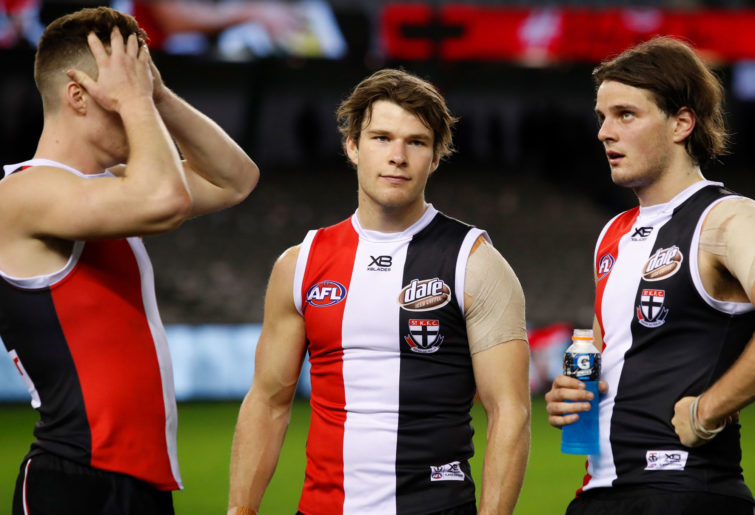
Sad St Kilda (Photo by Adam Trafford/AFL Media/Getty Images)
Tier V – the Gold Coast Suns
I love Gold Coast. I was a huge fan the moment the Little Master walked in the door a decade ago. I love what Stuart Dew has been trying to accomplish there. I can’t get enough of Two-metre Peter and Alex Sexton and Brayden Fiorini when they’re on.
I got excited when they started 3-and-2 last year, and I think the youngsters they’ve drafted have tremendous potential down the road.
But think about the maths involved here. In order to average 17.9 when you’re combining all the position predictions, you can’t include any numbers higher than 18, since there are only 18 finishing positions in the league.
So you cannot have more than one ranking even as high as 17th place without at least six other 18ths to balance it out (technically, it takes nine more, but if I’m rounding to the tenth, six 18s and one 17 makes an average of 17.857…, which’ll round up to 17.9). And there sure can’t be anything better than 17 – even a single 15th place would ruin the average, as it would take 17 more 18s to balance it out!
So, Gold Coast is so universally fated to land itself a wooden spoon that the prognosticators literally agreed to something like a 90 per cent level that the Suns would end up dead last this season.

Alex Sexton (right) of the Suns (AAP Image/Darren England)
Which is odd. And here’s why.
As I said, I took these rankings and the weighted averages, and I played out the season in advance (instead of my normal method of using the ELO-Following Football ratings, which I’ll write about sometime in March).
So generally, Tier I teams would win at home against almost anyone, Tier II teams might beat the tier above them at home but also might lose to a Tier III team on the road, and so forth. I ran the simulation three times with slightly differing parameters – different margins for different probability of wins, that sort of thing.
Very imprecise guesswork. (Again, since we’re wrong with at least 30per cent of the game forecasts, who cares about precision? They’re always exercises in futility.)
So, TL:DR, the Win-Loss record is the rounded average for all three simulations, with the average points above or below even listed on the right. (Thus, an average of zero would indicate a ladder percentage of 100.0 per cent, the same number of points scored as allowed.)
Here’s the result:
|
Team |
Avg Wins |
Avg Losses |
Avg Plus/Minus |
| 1 |
Richmond |
19.0 |
3.0 |
561 |
| 2 |
Melbourne |
17.3 |
4.7 |
503 |
| 3 |
West Coast |
16.7 |
5.3 |
422 |
| 4 |
Collingwood |
15.3 |
6.7 |
377 |
| 5 |
Geelong |
15.3 |
6.7 |
340 |
| 6 |
Adelaide |
14.7 |
7.3 |
220 |
| 7 |
Essendon |
13.0 |
9.0 |
201 |
| 8 |
GWS Giants |
11.7 |
10.3 |
179 |
| 9 |
Hawthorn |
11.3 |
10.7 |
94 |
| 10 |
No Melbourne |
11.3 |
10.7 |
12 |
| 11 |
Brisbane |
11.3 |
10.7 |
-26 |
| 12 |
Port Adelaide |
10.3 |
11.7 |
-72 |
| 13 |
Sydney |
9.3 |
12.7 |
-21 |
| 14 |
Fremantle |
6.0 |
16.0 |
-386 |
| 15 |
Western BD |
5.3 |
16.7 |
-418 |
| 16 |
St. Kilda |
4.7 |
17.3 |
-559 |
| 17 |
Gold Coast |
2.7 |
19.3 |
-705 |
| 18 |
Carlton |
2.7 |
19.3 |
-722 |
So, Richmond should finish much as they did 2018, which makes sense, as they should only get better this year in anticipation for the only part of the season that matters – September.
The schedule makers seem to have paved the way for Geelong and possibly Adelaide to be that break out teams to jump into the pack with the Demons, Eagles, and Magpies, with Essendon not very far behind. In all three simulations, those seven teams made finals easily.
Behind them are five teams projected to finish close to 11-11. In two of the simulations, the Giants were the eighth team in, and Hawthorn was the lucky eighth in the other. The three ninth-place finishes went to GWS (behind Hawthorn), North and Brisbane (behind the Giants). Neither Port nor Sydney were higher than eleventh in any of the three simulations, all falling in that 11th to 13th range.

Dustin Martin of the Tigers celebrates on the final siren . (Photo by Adam Trafford/AFL Media/Getty Images)
Speaking of how the ball bounces, Buckland’s article last week about the little adjustments that happen from year to year, like how close games tend to balance out and so forth, implied that the Lions were due to fly up the ladder if their expected growth matches up with said balancing – much farther up the ladder, in fact, than the Hawks, Giants, or ‘Roos. Maybe I should’ve taken that into account and moved the Lions up to eighth.
After that foursome, we see Fremantle in its coming-to-be-expected place on the ladder: leading the non-competitive. The rest of the ladder seems reasonable until you get to the very bottom – with the Blues below the Suns in percentage thanks to more competitive games for the latter.
Within all three simulations, the two finished with exactly the same record – either two or three wins apiece – but Gold Coast’s margins were slightly better than Carlton’s. If the Blues actually do win a second straight spoon, I would fear for the expiration of the patience of the Carlton fan-base.
So what do I now think is going to happen?
I find myself either being swayed by the masses predicting differently from my old guesses, or by the same draft, injury, and schedule things that affected their choices. Here’s my current guess.
Top Four
Like y’all, I’ll take Richmond, Collingwood, Melbourne and West Coast, probably in that order, with the healthiest of the bunch in September winning the title. (I still maintain it’s the Tigers’ trophy to lose, but their depth is gone, so if their injury list imitates that of GWS, they’re in trouble.)
Middle Nine
I see the same logjam everyone else does here – nine teams fighting for those last four finalist positions. Fifth place and thirteenth shouldn’t be separated by more than three games or so: maybe 13 wins on top, ten wins on the outs.
It seems like it’ll come down to which teams are getting better as the season goes along, and which ones aren’t.
Who are the four I see improving over the winter? I put Adelaide on top of this group in fifth, followed by GWS, Brisbane, and Essendon filling out the elimination finals. (Those four, that’s who.)
Sydney will be the first one outside the eight (I have an unreasonable faith that coach Longmire realises how to use the generational talent in his forward 50 this season), with Hawthorn and North just behind in tenth and 11th, and finally Geelong and Port pulling up the rear with a still-respectable record in 12th and 13th.
I know my simulations had the Cats much higher. But only six of their wins on average were “solid”, and with the core getting older, I’m not feeling particularly positive about my late wife’s favourite team. I see 10-12 as much more likely than 15-7.
Bottom five
This part’s not hard. Fremantle should be better than Footscray, St Kilda should be better than Carlton and Gold Coast, and the spoon should only go to Carlton IF their injuries deplete them more than the exodus depleted the Suns. Freo, Dogs, Saints, Blues, Suns.
Before the season starts, we’ll lay out the ELO-Following Football ratings for 2019, in addition to player predictions and more detailed forecasts for each team.
And I firmly believe that like every other pre-season prediction, mine is off by more than the minimum 30 per cent that ALL predictions err, just like yours is. The fun is in guessing where.



































































































